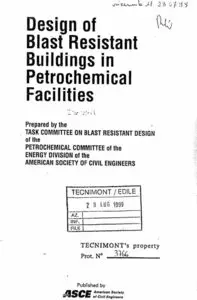Design of Blast Resistant Buildings in Petrochemical Facilities
American Society of Civil Engineers | English | ISBN 0784402655 | 272 pages | PDF | 10.76 MB | 1997
American Society of Civil Engineers | English | ISBN 0784402655 | 272 pages | PDF | 10.76 MB | 1997
The focus of this report is on structural aspects of designing or evaluating buildings for blast resistance. Generally this involves quantifying the blast overpressures that could result from accidental explosions, establishing the design blast loads from these overpressures, setting the structural performance requirements, and designing the building structure to withstand these loads within the required performance limits. Blast resistant design, or the structural strengthening of buildings, is one of the measures an owner may employ to minimize the risk to people and facilities from the hazards of accidental explosions in a plant. Other mitigative or preventive measures, including siting (adequate spacing from potential explosion hazards) and hazard reduction (inventory and process controls, occupancy limitations, etc.), arc not covered in this report.
This report is intended to be a Slate-of-thc-Practice set of guidelines. The recommendations provided are based on published information and actual design. A review of current practice, internal company standards, published documents, and the current work of related groups was conducted The report includes a list of references to provide additional information. The reference list emphasizes an emphasis on readily available commercial publications and government reports. Because of their relevance to this report, several publications deserve mention here. Two widely used documents dealing generally with blast resistant design are 'JM5-I300. Structures to Resist the Effects 0/Accidental Explosions from the Department of Defense and ASCE manual 42, Design of Structures to Resist Nuclear Weapons Effects. Two publications which greatly supplement chapters 2 and 3 are Guidelines for Evaluating the Characteristics of Vapor Cloud Explosions, Flash Fires, and BLEVEs; and Guidelines for Evaluating Process Plant Buildings for External Explosions and Fires, These last two documents are from the AlChE Center for Chemical Process Safety.



